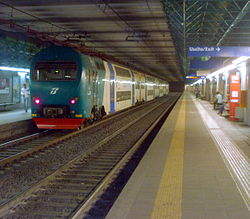| FL lines | |||
|---|---|---|---|
 TAF train at Balduina station | |||
| Overview | |||
| Area served | Rome metropolitan area, Lazio | ||
| Locale | Rome, Lazio | ||
| Transit type | Commuter rail | ||
| Number of lines | 8 | ||
| Number of stations | 131 | ||
| Daily ridership | 286,241[1] | ||
| Website | trenitalia.com | ||
| Operation | |||
| Began operation | 1994 | ||
| Operator(s) | Trenitalia | ||
| Infrastructure manager(s) | Rete Ferroviaria Italiana | ||
| Rolling stock | E.464, TAF, Jazz, ETR 421/521/621 Rock | ||
| Technical | |||
| System length | 672 km (417.6 mi) | ||
| Track gauge | 1,435 mm (4 ft 8+1⁄2 in) standard gauge | ||
| Electrification | 3 kV DC, overhead line | ||
| |||
The FL lines, formerly Lazio regional railways (Italian: ferrovie regionali del Lazio, also Ferrovie Laziali) consist of 8 commuter rail lines operated by Trenitalia, converging on the city of Rome. It operates as a combined suburban railway system that connects the city-centre and the outskirts of the city via a commuter rail line.[2]
The FL network, initially made up of two lines and called FM lines (Metropolitan Railways), was formally inaugurated in 1994, following the signing of an agreement between the Lazio Region, the Municipality of Rome, the Province of Rome and Ferrovie dello Stato Italiane, aimed at implementing a new integrated transport structure in the Roman metropolitan and regional area.[3]
Lines FL1, FL2 and FL3 function like a rapid transit service, integrated with the Rome Metro and surface transportation. The other lines (numbered from FL4 to FL8) mostly serve the suburban area of Rome and the Lazio region, and used almost exclusively for commuter traffic.
- ^ Cite error: The named reference
Carta servizi 2024was invoked but never defined (see the help page). - ^ "Piano Regionale della Mobilità, dei Trasporti e della Logistica - Il nodo ferroviario" [Regional Mobility, Transport and Logistics Plan - The railway hub] (PDF) (in Italian). Regione Lazio, Centro di ricerca per il trasporto e la logistica, Sapienza University of Rome. December 2020.
- ^ "LAZIO SU ROTAIA" (PDF) (in Italian). Dimensione Trasporti.
